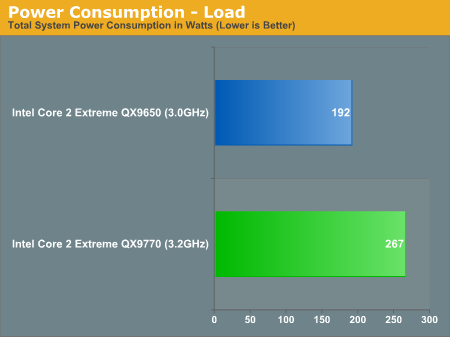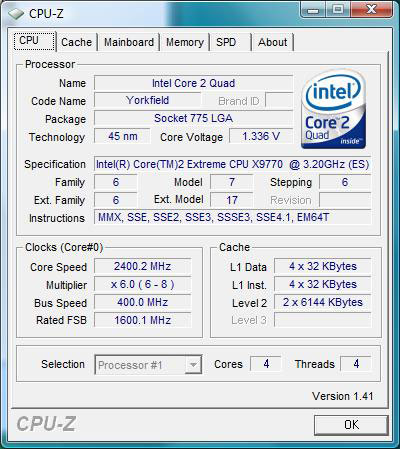Core 2 Extreme QX9770: Not so hot after all?
by Anand Lal Shimpi on November 21, 2007 12:00 AM EST- Posted in
- Anand
As I mentioned in our Core 2 Extreme QX9770 Preview, my chip got pretty hot. Both Gary and I had QX9770 samples that could barely run at 3.2GHz without added cooling, not to mention that both of our CPUs consumed significantly more power than the highly overclockable QX9650 we reviewed just a few weeks earlier.
Here's a graph from the review, showing how my QX9770 stacked up against the QX9650:

I had a meeting with Intel today to discuss the issues and they provided some insight. The chip I have should run at a 1.2875V core voltage, but as you'll see from the below CPU-Z screenshot, it did not:

Now the 1.336V core voltage alone isn't enough to make up for the power difference I reported, but it was responsible for some. Why was my chip running at a higher core voltage? The BIOS was set to auto-detect the core voltage but it appears that there may be something wrong with the way the ASUS P5E3 Deluxe BIOS handles the QX9770.
Gary just forwarded me a new BIOS revision that supposedly fixes the problem, but that doesn't put us in the clear just yet. Intel is going to get back to me within the next day or so with a full analysis of whether or not I have a bad chip, or if the higher core voltage alone is the only abnormality in what I saw.
Even at a lower core voltage my QX9770 ended up consuming around 30W more power than the QX9650, but it's quite possible that I have a really bad QX9770 and a really good QX9650. Individual chips, even at the same frequency, can have vastly different operating voltages - which we already knew. But it's also possible to get a range of power consumption between chips at the same frequency and same voltage; meaning that it's possible to have two QX9770s with the same operating voltage, but significantly different power consumption characteristics.
I always figured that voltage was the primary determinant of how two otherwise identical processors performed from a power perspective, but it turns out I was wrong.
In any case, it looks like the QX9770 issues may not be nearly as big of a concern as I originally thought. At this point it looks like a BIOS problem + hotter than normal chip, but I'll let you know if Intel comes back with anything different.
On a related note, it looks like Intel will eventually begin shipping its Extreme processors with a better heatsink; I should have one in the coming weeks. Now if Intel could only do something about that damned mounting system we'd be getting somewhere.










8 Comments
View All Comments
Luminair - Monday, November 26, 2007 - link
"I always figured that voltage was the primary determinant of how two otherwise identical processors performed from a power perspective, but it turns out I was wrong."No you were right! Either the chips will perform very similarly when clocked and powered the same, or those chips are not identical :)
MrSpadge - Monday, November 26, 2007 - link
"Either the chips will perform very similarly when clocked and powered the same, or those chips are not identical :)"From a pragmatic point of view you're absolutely right. However, there are at least two kinds of "identical" here: logical and physical. In my post above I talked a bit about how the chips could be logically identical but still differ a lot physically, despite using the same stepping and/or whatever.
Stephan
aguilpa1 - Wednesday, November 21, 2007 - link
If the QX6950 won't work then this new hotter beast sure wont. Why is no one investigating why the Yorkfields that we where assured to work on 680i motherboards will NOT work now???nemrod - Wednesday, November 21, 2007 - link
They will work on 680i but probably not too well overclock... But perhaps, you should ask nvidia why they prefer sell news chipsets 780i than support already sold one...MrSpadge - Wednesday, November 21, 2007 - link
[quote]"I always figured that voltage was the primary determinant of how two otherwise identical processors performed from a power perspective, but it turns out I was wrong.[/quote]If the chips were indeed identical, you would still be right (for a single chip voltage is the primary determinant). However, if you consider the small structures we are dealing with, gate oxide thicknesses of 1.2 nm / a few mono layers (!), and the large influence which they can have on device performance (gate leakage current depending exponentially on gate oxide thickness), it can be seen that:
- it's inevitable to have some variation within each chip, between the chips on each wafer and between the batches (won't go into the reasons now)
- the smaller the structures get and the more transistors we pack into each chip, the more pronounced the effect of such variations becomes
The hafnium-based high-k oxide in Intels 45 nm process enables them to use thicker oxide and achieve the same electrical performance, so gate leakage should not be the problem here. But there are many more transistor parameters to consider and other leakage paths (substrate to gate, subthreshold current).
Having said that I can imagine that Intel:
- may have used a thinner gate oxide intentionally to increase frequency headroom, but got unexpected results from the rather new material system "Hf-oxide + metal gate" (higher leakage due to a higher defect density in the oxide, tunneling via Poole-Frenkel emission)
- may have gotten a "normal" variation in the process and, as you suggested, your X9650 may have been somewhat lucky
- may have gotten an unintentional variation in some process parameters
- may come up with some, for ousiders, totally unexpected explanation
So, depending on what Intel tells you, it may be a good idea to keep an eye on the variation of power consumption between chips from different batches of Intels 45 nm process.
Regards, Stephan
IntelUser2000 - Thursday, November 22, 2007 - link
Problem is that other review sites aren't showing such a disparity between the QX9650 and QX9770 and some like Neoseeker does: http://www.legitreviews.com/article/596/11/">http://www.legitreviews.com/article/596/11/MrSpadge - Thursday, November 22, 2007 - link
"Funny" about Neoseeker is that they fail to recognize this CPU chewing ~50W more for a ~7% higher clock speed as unusual.Stephan
ViRGE - Wednesday, November 21, 2007 - link
Has Intel said anything about how they'll be handling mounting for the new socket Nehalem will use? If they were going to change the mounting system, that would be their chance.